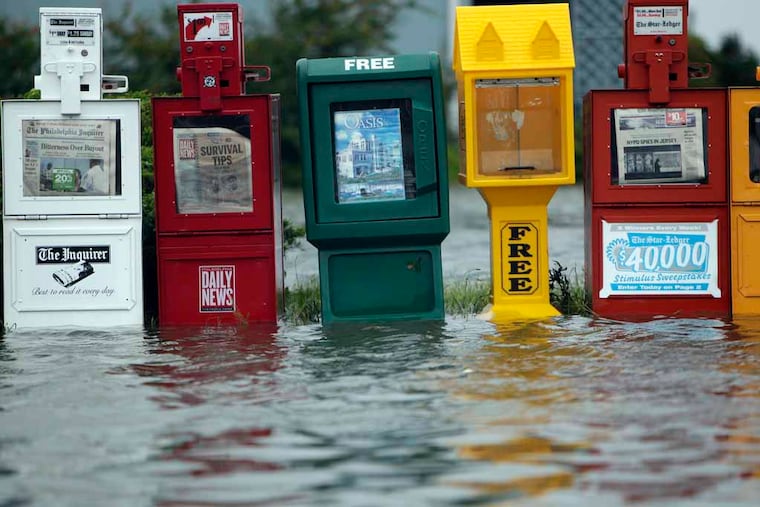Pennsylvania’s news deserts threaten to keep communities in the dark and vulnerable
News deserts, like actual deserts, develop over time, not overnight. A significant number of news outlets throughout the country — and in our state specifically — are disappearing like a mirage.

In Philadelphia, we are blessed to have a fairly robust media landscape. But that does not mean there aren’t pockets across the city where news deserts — defined as communities with limited access to credible, comprehensive news — exist.
I have had the privilege of working with two organizations that have helped fill the void of news deserts in the city. The first was serving as cochair of Resolve Philly, which is a nonprofit news organization dedicated to informing and lifting community voices.
Some years earlier, I was honored to serve as general manager of 900 AM WURD, Pennsylvania’s only Black-owned talk radio station. Both still play critical roles in Philly’s media market and are blooming despite sometimes challenging terrain.
But news deserts, like actual deserts, develop over time, not overnight. And a significant number of news outlets throughout the country — and in Pennsylvania specifically — are disappearing like a mirage.
While we live in a 24/7 news cycle that floods us with information, we also have to contend with a proliferation of social media influencers who often pollute those waters with disinformation, poorly researched facts, and lies presented as truth. Across the United States, communities are grappling with the disappearance of news sources that once held power to account and kept residents informed about decisions shaping their daily lives.
Communities are grappling with the disappearance of news sources that once held power to account and kept residents informed.
Over the past 20 years, the United States has lost more than 3,200 newspapers, with two more shuttering every week, according to Northwestern University’s Medill School of Journalism, which closely follows the industry. Of the fewer than 5,600 newspapers that remain, about 80% are weeklies. These closures have left areas vulnerable with little or no access to credible, original reporting.
The Keystone State is no exception.
In the 67 counties that comprise Pennsylvania, two have lost their only news sources, and news outlets in many rural areas have only one or two reporters covering them.
Pittsburgh and Philadelphia still maintain viable news organizations, but the struggle to remain sustainable is ever-present. Admittedly, some of our venerable news institutions have fallen victim to various market forces and shifting business models.
The federal government’s actions targeting the Corporation for Public Broadcasting and National Public Radio may further silence voices that provide rural communities one of the few reliable sources still available to them.
Silent voices, of course, have no ability to inform or hold power accountable.
No oversight.
No scrutiny.
No protector of the public interest.
In the absence of credible journalism, the desert that begins to form is a treacherous landscape full of misinformation, unchecked rumors, or viral content crafted more for outrage than accuracy. Without reliable information, communities become less engaged and, ultimately, less democratic.
But even the most arid desert can be transformed into more fertile ground with the right nutrients to do so.
This month, several universities — including Temple — are convening the state’s first-ever Keystone News Summit. The purpose is to gather journalists, educators, funders, and policymakers to find ways to rebuild sustainable models for local journalism and prevent the further erosion of news outlets across the commonwealth. The solutions are varied, ranging from university partnerships and nonprofit newsrooms to creative business models and government support.
Even the most arid desert can be transformed into more fertile ground with the right nutrients to do so.
The key to a successful summit will be whether the solutions that emerge can be implemented and sustained over time. But that depends on the communities and the people in them that these outlets intend to serve. Will they support them financially? Will the content be valuable enough to matter? Will there be sufficient trust between consumer and outlet to have the type of reliable relationship that serves as the bedrock of journalistic integrity?
The answers to these questions could help determine how and where news deserts in Pennsylvania can be turned around to serve communities thirsting for information. Tilling this dry soil, however, is only the first step of a longer process that we hope will yield the kind of strong news ecosystem that can enlighten, engage, and empower those who have gone without for so long.
Only time will tell if a more robust media environment can emerge from this effort. If so, it will be the kind of harvest that will benefit us all.
David W. Brown is an associate professor and assistant dean for community and communication at the Klein College of Media and Communication at Temple University.